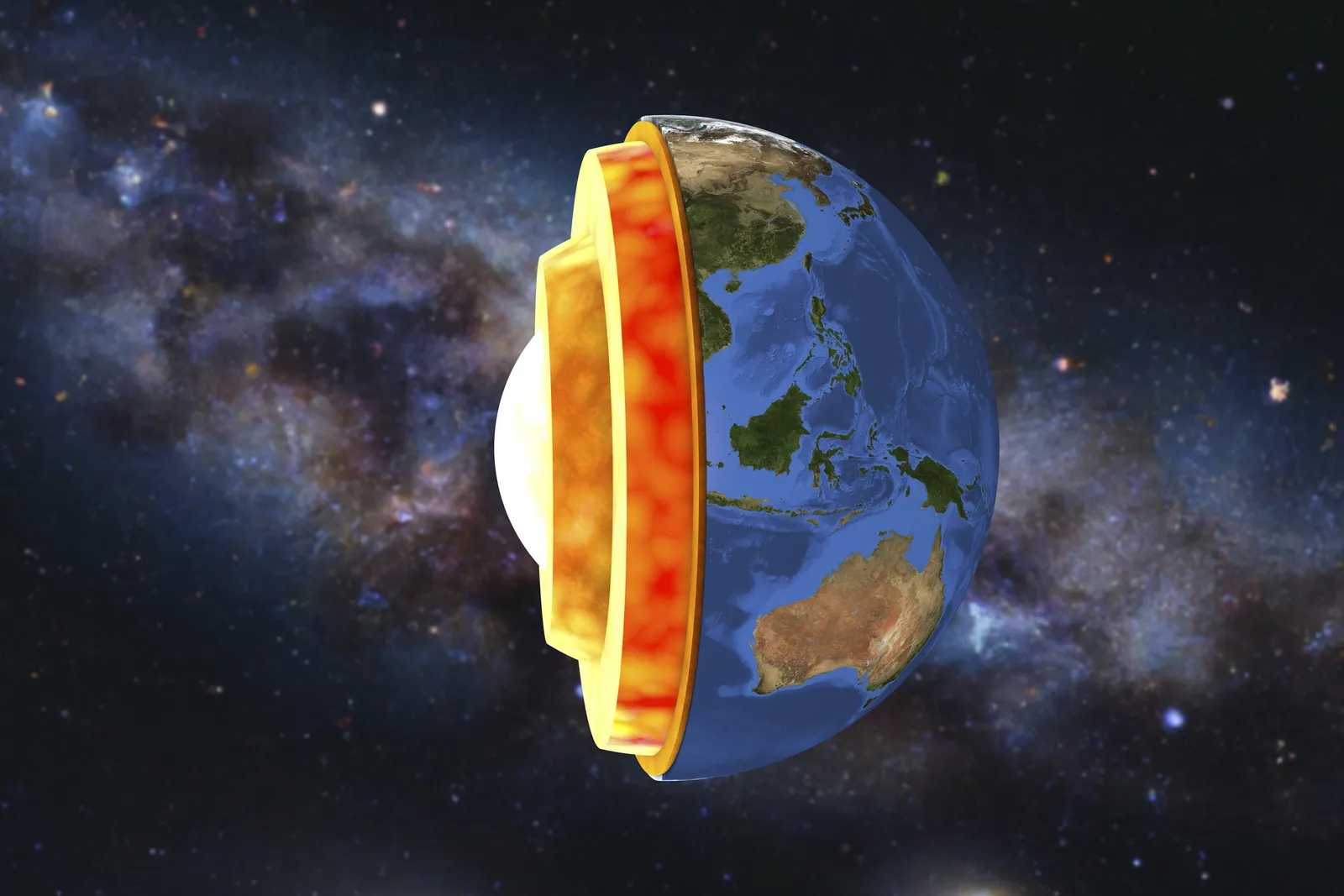What Are The Evidence Of Earth’s Interior?
The Earth is made up of three layers: the crust, the mantle and the core. Evidence of Earth’s interior has been studied for centuries by geologists, seismologists, and other scientists. This evidence has been obtained through seismic waves, laboratory experiments, and other methods. Seismic waves are used to measure the Earth’s interior structure and composition, as well as to map the boundaries between the Earth’s layers. Laboratory experiments have been conducted to estimate properties of the Earth’s mantle and core, such as temperature, pressure, and composition. Other evidence comes from studying the age and composition of rocks from different depths in the Earth’s crust. With all of this evidence, scientists have been able to gain a better understanding of the Earth’s interior, including its composition, temperature, and pressure.
Introduction
Earth’s interior structure is an intriguing subject for scientists, geologists, and other experts to explore. It is believed that Earth’s core is made up of a hot, dense, iron-nickel alloy with temperatures as high as 6000°C. The mantle is a thick layer of solid rock that lies between the core and the crust. The outermost layer of the Earth is the crust, which is composed of several different types of rocks. Evidence of Earth’s interior structure can be seen in seismic activities, magnetic field, and other geological studies.
Seismic activities can be used to infer the interior structure of the Earth. The study of seismic waves that travel through the Earth provides valuable information about the composition, temperature, and pressure of Earth’s interior. The waves are recorded on seismometers which then analyze the data for various characteristics. Seismic waves can also be used to measure the thickness of Earth’s various layers.
The Earth’s magnetic field is another indicator of the planet’s interior structure. The magnetic field is generated by the motion of the liquid iron-nickel alloy in the Earth’s core. The strength and direction of the magnetic field can be used to infer the amount and type of material within the core.
Finally, geological studies of the Earth’s surface can provide valuable information about the Earth’s interior structure. Geological features such as volcanoes, mountains, and tectonic plates are all clues to the Earth’s makeup and reveal the forces that help shape the planet. By studying these features, scientists can gain insight into the Earth’s interior structure.
In conclusion, evidence of Earth’s interior structure can be found in seismic activities, magnetic field, and geological studies. By studying these features, scientists can gain a better understanding of the Earth’s composition and the forces that help shape it.
Composition of Earth’s Interior
Earth’s interior is composed of several layers that differ substantially in composition and temperature. The core is the innermost layer and is composed mostly of iron and nickel, with smaller amounts of sulfur and other elements. This layer is extremely hot, with temperatures reaching up to 6,000 degrees Celsius. The outer core is liquid, while the inner core is solid.
The mantle is the middle layer of the Earth’s interior, and is composed of semi-molten rock called magma. This layer is primarily made up of oxides of silicon and magnesium, with smaller amounts of other elements. The temperature of the mantle ranges from 2,000 to 6,000 degrees Celsius.
The crust is the outermost layer of the Earth’s interior. It is composed of relatively thin, solid plates of rock. These plates are made up of oxides of aluminum, silicon, oxygen, and other elements. The temperature of the crust varies depending on the depth, but is typically between 500 and 1,500 degrees Celsius.
These layers not only differ in composition and temperature, but also in density. The innermost layers are the densest, while the outermost layers are the least dense. This distribution of density is responsible for the Earth’s gravitational field and is also the driving force behind plate tectonics. Understanding the composition and temperature of the Earth’s interior is essential for understanding how the planet works.
Temperature and Pressure in Earth’s Interior
Our planet Earth is much more than a beautiful blue marble suspended in space. Its surface is just the beginning of a much more complex and mysterious realm beneath. While we can’t journey to the center of the Earth, we can gain insight into what lies beneath us through evidence of Earth’s interior. Temperature and pressure are two of the most important indicators of what lies beneath the Earth’s crust.
Temperature plays a key role in how the Earth’s interior is formed and how it works. The deeper you go into the Earth, the hotter it gets. This is due to the decay of radioactive elements that are present in Earth’s crust. The temperature of the Earth’s core is estimated to be around 6,000°C, while the temperature of the mantle is around 4,000°C.
Pressure also increases the deeper you go into the Earth. The pressure on the Earth’s core is estimated to be around 3.5 million times greater than the pressure at the Earth’s surface. This tremendous pressure is what helps keep the Earth intact and make it the planet it is today.
By understanding the temperature and pressure of Earth’s interior, we can gain valuable insight into the inner workings of our planet and the forces that shape it. So while we may never reach the depths of the Earth, we can still unravel the mysteries of what lies beneath.

Earth’s Core
and Mantle
Earth’s interior is made up of two distinct layers: the core and the mantle. The core is the innermost layer, located at the center of the planet, and is composed primarily of iron and nickel. The mantle is the layer just outside the core and is primarily composed of silicate rocks. Both the core and mantle are divided into two distinct parts: the outer core and the inner core.
The outer core is a liquid layer made up of iron and nickel that is located between the mantle and the inner core. This layer is responsible for generating Earth’s magnetic field, which shields the planet from harmful cosmic radiation. The inner core is a solid, extremely hot layer at the center of the planet composed primarily of iron and nickel. This layer is believed to be the source of the planet’s heat and is responsible for the movement of tectonic plates.
The core and mantle play an important role in regulating Earth’s climate, as well as in the formation of its landforms. The core and mantle, along with the crust, are also responsible for creating the current movement of the tectonic plates that form the continents. This movement is responsible for the creation of mountains, volcanoes, and other geological features.
Mantle
convection, seismic waves, and magnetic field reversals are just a few of the evidence that give us a glimpse into Earth’s interior.
Earth’s interior is a secret that has been hidden away for millions of years. Scientists have long been fascinated by what lies beneath the surface, and have used a variety of methods to gain insight into the Earth’s inner workings. From mantle convection to seismic waves to magnetic field reversals, there is a wealth of evidence that can give us an idea of what lies beneath the Earth’s crust.
Mantle convection is the process of hot material rising and cooler material sinking, which occurs in the Earth’s mantle. This convection helps to move the tectonic plates and can be observed from the surface. Seismic waves are generated by earthquakes and other seismic events, and can be used to map out the Earth’s interior structure. Finally, magnetic field reversals are when the Earth’s magnetic field flips, which occurs over geologic timescales and provides evidence of the Earth’s magnetic field history.
Overall, these three pieces of evidence are just a few of the many that give us a glimpse into the Earth’s interior. By studying these phenomena, scientists can gain a better understanding of the Earth’s structure and how it works.
Crust
, mantle, and core are three distinct layers that make up Earth’s interior. Evidence of these layers comes from a variety of sources, including seismic studies, laboratory experiments, and geological features.
Seismic studies provide evidence for Earth’s interior layers by analyzing seismic waves and how they travel through the planet. Seismic waves are generated by earthquakes, and they can be detected on seismographs. By studying the speed and direction of these waves, scientists can determine the interior structure of Earth. Laboratory experiments can also be used to simulate the conditions of Earth’s interior. By studying the effects of high temperatures and pressures on rock samples, scientists can gain insight into what the Earth’s interior might look like.
Geological features on the planet’s surface can also provide evidence of Earth’s interior. For example, volcanic eruptions can reveal information about the mantle, while oceanic trenches can point to evidence of the Earth’s core. By studying the features of the Earth’s surface, scientists can gain valuable insights into the composition of the planet’s interior.
Overall, evidence of Earth’s interior layers comes from seismic studies, laboratory experiments, and geological features. By studying these areas, scientists can gain a better understanding of the planet’s interior and the processes that shape it.
FAQs About the What Are The Evidence Of Earth’s Interior?
Q1. What physical evidence do scientists use to study Earth’s interior?
A1. Scientists use a variety of physical evidence to study Earth’s interior, such as geological, geochemical, geophysical, and seismic data. This data can be used to study the composition, structure, and dynamics of the Earth’s interior.
Q2. How do scientists measure the temperature of Earth’s interior?
A2. Scientists measure the temperature of Earth’s interior using advanced seismic and geophysical instruments. These instruments measure the pressure, temperature, and density of the material within the Earth’s interior.
Q3. What is the lithosphere and how does it relate to Earth’s interior?
A3. The lithosphere is the outermost layer of Earth’s interior, and it consists of the crust and the uppermost mantle. It is the layer in which most geological processes occur, and it is where the majority of Earth’s seismic activity is concentrated.
Conclusion
The evidence of Earth’s interior is vast and varied, ranging from seismic data gathered through earthquakes and other seismic events to the study of mantle plumes and their effects on the surface of the planet. Evidence from experiments also provides insight into the composition of the Earth’s interior, such as its temperatures and densities. While much of the Earth’s interior remains a mystery, the evidence gathered from various sources provides a better understanding of the Earth’s structure and the processes occurring beneath the surface.







